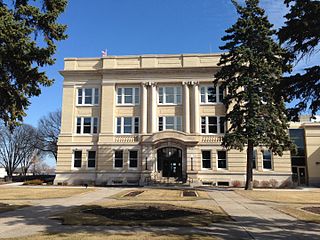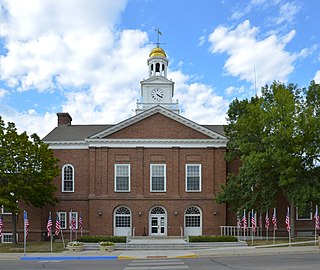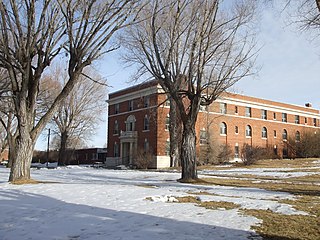
Otter Tail County is a county in the U.S. state of Minnesota. As of the 2010 United States Census, the population was 57,303. Its county seat is Fergus Falls.

Fergus Falls is a city in and the county seat of Otter Tail County, Minnesota, United States. The population was 13,138 at the 2010 census.

The Kirkbride Plan was a system of mental asylum design advocated by Philadelphia psychiatrist Thomas Story Kirkbride (1809–1883) in the mid-19th century. The asylums built in the Kirkbride design, often referred to as Kirkbride Buildings, were constructed during the mid-to-late-19th century in the United States. The structural features of the hospitals as designated by Dr. Kirkbride were contingent on his theories regarding the healing of the mentally ill, in which environment and exposure to natural light and air circulation were crucial. The hospitals built according to the Kirkbride Plan would adopt various architectural styles, but had in common the "bat wing" style floor plan, housing numerous wings that sprawl outward from the center.

The Danvers State Hospital, also known as the State Lunatic Hospital at Danvers, The Danvers Lunatic Asylum, and The Danvers State Insane Asylum, was a psychiatric hospital located in Danvers, Massachusetts. It was built in 1874, and opened in 1878, under the supervision of prominent Boston architect Nathaniel Jeremiah Bradlee, on an isolated site in rural Massachusetts. It was a multi-acre, self-contained psychiatric hospital designed and built according to the Kirkbride Plan.

Bryce Hospital opened in 1861 in Tuscaloosa, Alabama, United States. It is Alabama's oldest and largest inpatient psychiatric facility. First known as the Alabama State Hospital for the Insane and later as the Alabama Insane Hospital, the building is considered an architectural model. The hospital currently houses 268 beds for acute care, treatment and rehabilitation of full-time (committed) patients. The Mary Starke Harper Geriatric Psychiatry Hospital, a separate facility on the same campus, provides an additional 100 beds for inpatient geriatric care. The main facility was added to the National Register of Historic Places in 1977.

Taunton State Hospital is a psychiatric hospital located on Hodges Avenue in Taunton, Massachusetts. Established in 1854, it was originally known as the State Lunatic Hospital at Taunton. It was the second state asylum in Massachusetts. Most of the original part of the facility was built in a unique and rare neo-classical style designed by architects Boyden & Ball. It is also a Kirkbride Plan hospital and is located on a large 154-acre (62 ha) farm along the Mill River.

Greystone Park Psychiatric Hospital referred to both the former psychiatric hospital and the historic building that it occupied in Morris Plains, New Jersey. Built in 1876, the facility was built to alleviate overcrowding at the state's only other "lunatic asylum" located in Trenton, New Jersey. Originally built to accommodate 350 people, the facility, having been expanded several times, reached a high of over 7700 patients resulting in unprecedented overcrowding conditions. In 2008, the facility was ordered to be closed as a result of deteriorating conditions and overcrowding. A new facility was built on the large Greystone campus nearby and bears the same name as the aging facility. Despite considerable public opposition and media attention, demolition of the main Kirkbride building began in April 2014 and was completed by October 2015.

The Minnesota Security Hospital is a secure psychiatric hospital located in St. Peter, Minnesota. It serves people who have been committed by the court as mentally ill and dangerous. It was established as St. Peter State Hospital in 1866 under the Kirkbride Plan. The original building is mostly demolished though the hospital is still active.

Oregon State Hospital is a public psychiatric hospital in the U.S. state of Oregon, located in the state's capital city of Salem with a smaller satellite campus in Junction City opened in 2014. Founded in 1862 and constructed in the Kirkbride Plan design in 1883, it is the oldest operating psychiatric hospital in the state of Oregon, and one of the oldest continuously operated hospitals on the West Coast.

The Institute of Pennsylvania Hospital, also known as Kirkbride's Hospital or the Pennsylvania Hospital for Mental and Nervous Diseases, was a psychiatric hospital located at 48th and Haverford Streets in Philadelphia, Pennsylvania, USA. It operated from its founding in 1841 until 1997. The remaining building, now called the Kirkbride Center is now part of the Blackwell Human Services Campus.

Thomas Story Kirkbride was a physician, advocate for the mentally ill, and founder of the Association of Medical Superintendents of American Institutions for the Insane (AMSAII), a precursor to the American Psychiatric Association.

Dixmont State Hospital was a hospital located northwest of Pittsburgh, Pennsylvania. Built in 1862, Dixmont was once a state-of-the-art institution known for its highly self-sufficient and park-like campus, but a decline in funding for state hospitals and changing philosophies in psychiatric care caused the hospital to be closed in 1984. After more than two decades of abandonment, it was finally demolished in 2006. The campus spanned a total of 407 acres (165 ha). Reed Hall is listed on the National Register of Historic Places.

Central State Hospital, formally referred to as the Central Indiana Hospital for the Insane was a psychiatric treatment hospital in Indianapolis, Indiana.

The Trans-Allegheny Lunatic Asylum, subsequently the Weston State Hospital, was a Kirkbride psychiatric hospital that was operated from 1864 until 1994 by the government of the U.S. state of West Virginia, in the city of Weston. Weston State Hospital got its name in 1913 which was used while patients occupied it, but was changed back to its originally commissioned, unused name, the Trans-Allegheny Lunatic Asylum, after being reopened as a tourist attraction.

Asylum Architecture in the United States, including the architecture of psychiatric hospitals, affected the changing methods of treating the mentally ill in the nineteenth century: the architecture was considered part of the cure. Doctors believed that ninety percent of insanity cases were curable, but only if treated outside the home, in large-scale buildings. Nineteenth-century psychiatrists considered the architecture of asylums, especially their planning, to be one of the most powerful tools for the treatment of the insane, targeting social as well as biological factors to facilitate the treatment of mental illnesses. The construction and usage of these quasi-public buildings served to legitimize developing ideas in psychiatry. About 300 psychiatric hospitals, known at the time as insane asylums or colloquially as “loony bins” or “nuthouses,” were constructed in the United States before 1900. Asylum architecture is notable for the way similar floor plans were built in a wide range of architectural styles.

The Hudson River State Hospital, is a former New York state psychiatric hospital which operated from 1873 until its closure in the early 2000s. The campus is notable for its main building, known as a "Kirkbride," which has been designated a National Historic Landmark due to its exemplary High Victorian Gothic architecture, the first use of that style for an American institutional building. It is located on US 9 on the Poughkeepsie-Hyde Park town line.

Worcester State Hospital was a Massachusetts state mental hospital located in Worcester, Massachusetts. It is credited to the architectural firm of Weston & Rand. The hospital and surrounding associated historic structures are listed as Worcester Asylum and related buildings on the National Register of Historic Places.

The Independence State Hospital was built in 1873 as the second asylum in the state of Iowa. It is located in Independence, Iowa. The original plan for patients was to relieve crowding from the hospital at Mount Pleasant and to hold alcoholics, geriatrics, drug addicts, mentally ill, and the criminally insane. It was built under the Kirkbride Plan. The hospital's many names include: The Independence Lunatic Asylum, The Independence State Asylum, The Independence Asylum for the Insane, The Iowa State Hospital for the Insane, and The Independence Mental Health Institute. There is also a labyrinth of tunnels which connect every building. Like most asylums of its time, it has had a gruesome and dark history. Remnants of this are the graveyard, hydrotherapy tubs, and lobotomy equipment.
The Clarinda Treatment Complex was built in 1884 as the Clarinda State Hospital in Clarinda, Iowa in southwest Iowa. It was the third asylum in the state of Iowa. The hospital's many name variations include: The Clarinda Lunatic Asylum, The Clarinda State Asylum, The Clarinda Asylum for the Insane, and The Clarinda Mental Health Institute. It was built under the Kirkbride Plan. The original plan for patients was to hold alcoholics, geriatrics, drug addicts, mentally ill, and the criminally insane. In 2009, it was made public that, to save money, the state may close one of the four hospitals in Iowa. On June 30, 2015, the hospital facility was shut down and all patient services terminated. The Clarinda Academy, owned by Sequel Youth Services, is the sole occupant of the former hospital grounds.

Central State Hospital, originally known as the Central Lunatic Asylum, is a psychiatric hospital in Petersburg, Virginia, United States. It was the first institution in the country for "colored persons of unsound mind".






















